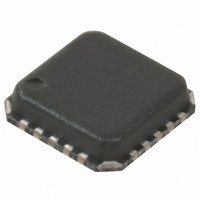RF2483TR7 RFMD, RF2483TR7 Datasheet - Page 10

RF2483TR7
Manufacturer Part Number
RF2483TR7
Description
IC QUADRATURE MOD DUAL-BND 20QFN
Manufacturer
RFMD
Datasheet
1.RF2483PCK-410.pdf
(28 pages)
Specifications of RF2483TR7
Function
Modulator
Lo Frequency
700MHz ~ 2.2GHz
Rf Frequency
700MHz ~ 2.2GHz
P1db
6dBm
Noise Floor
-156.7dBm/Hz
Output Power
3dBm
Current - Supply
110mA
Voltage - Supply
2.7 V ~ 3.3 V
Test Frequency
1.9GHz
Package / Case
20-QFN
Lead Free Status / RoHS Status
Lead free / RoHS Compliant
Other names
689-1015-2
Available stocks
Company
Part Number
Manufacturer
Quantity
Price
Company:
Part Number:
RF2483TR7
Manufacturer:
M/A-COM
Quantity:
5 000
Part Number:
RF2483TR7
Manufacturer:
RF
Quantity:
20 000
RF2483
10 of 28
Pin
13
14
15
16
18
17
RF OUT LB
Function
GC DEC
QSIG P
GND2
VREF
GC
Description
Quadrature Q channel positive baseband input port.
Best performance is achieved when the ISIGP and ISIGN are driven differ-
entially. The recommended CW differential drive level (V
800mV
This input should be DC-biased at 1.2V±0.05V. The common-mode DC
voltage on the QSIGP and QSIGN input signals is used to bias the modula-
tor. In sleep mode an internal FET switch is opened, the input goes high
impedance and the modulator is de-biased. The input impedance is typi-
cally 5.5kΩ at low frequencies and at higher frequencies can be modeled
as 50Ω in series with 12pF to ground.
Phase or amplitude errors between the QSIGP and QSIGN signals which
may result in an increase in the even order distortion of the modulation in
the output spectrum.
DC offsets between the QSIGP and QSIGN signals will result in an
increased carrier leakage. Small DC offsets may be deliberately applied
between the ISIGP/ISIGN and QSIGP/QSIGN inputs to cancel out the LO
leakage. The optimum corrective DC offsets will change with mode, fre-
quency and gain control.
Common-mode noise on the QSIGP and QSIGN should be kept low as it
may degrade the noise performance of the modulator.
Phase offsets may be applied between the I and Q channels to improve the
sideband suppression performance.
Voltage reference decouple with an external 10nF capacitor to ground.
The voltage on this pin is typically 1.67V when the chip is enabled. The
voltage is 0V when the chip is powered down.
The purpose of this decoupling capacitor is to filter out low frequency noise
(20MHz) on the gain control lines.
Poor positioning of the VREF decoupling capacitor can cause a degrada-
tion in LO leakage.
A voltage of around 2.5V on this pin indicates that the die flag under the
chip is not grounded and the chip is not biased correctly.
Voltage reference decouple with an external 1nF decoupling capacitor to
ground.
The voltage on this pin is a function of gain control (GC) voltage when the
chip is enabled. The voltage is 0V when the chip is powered down.
The purpose of this decoupling capacitor is to filter out low frequency noise
(20MHz) on the gain control lines. The size of the capacitor on the GC DEC
line will effect the settling time response to a change in gain control volt-
age. A 1nF capacitor equates to around 200ns settling time and a 0.5nF
capacitor equates to a 100ns settling time. There is a trade-off between
settling time and noise contributions by the gain control circuitry as gain
control is applied.
Poor positioning of the VREF decoupling capacitor can cause a degrada-
tion in LO leakage.
Gain control voltage. Maximum output power at 2.0V. Minimum output
power at 0V. When the chip is enabled the input impedance is 10kΩ refer-
enced to 1.7V
and the input goes high impedance.
RF low band output. Open collector output.
The output should be biased at VCC through an inductor that can be used
to form part of an output matching circuit.
In our proposed applications circuit some power is dissipated in R6 (130Ω)
which appears as a de-Qing resistor in parallel with the output inductor L4.
If R6 is eliminated and the RFOUT LB pin is re-matched to 50Ω it is possi-
ble to get approximately 5dB extra power out of the device in low band
mode.
Ground for RF output sections.
7628 Thorndike Road, Greensboro, NC 27409-9421 · For sales or technical
support, contact RFMD at (+1) 336-678-5570 or sales-support@rfmd.com.
P-P
.
DC
. When the chip is powered down a FET switch is opened
QSIGP
-V
QSIGN
) is
Interface Schematic
V
C C 2
V
10 kΩ
4 kΩ
4 kΩ
C C 2
+
-
+
-
5 0 Ω
Rev A9 DS080403
1 2 p F
1.7 V
4 kΩ
V
+
-
V
CC2
C C 2



















